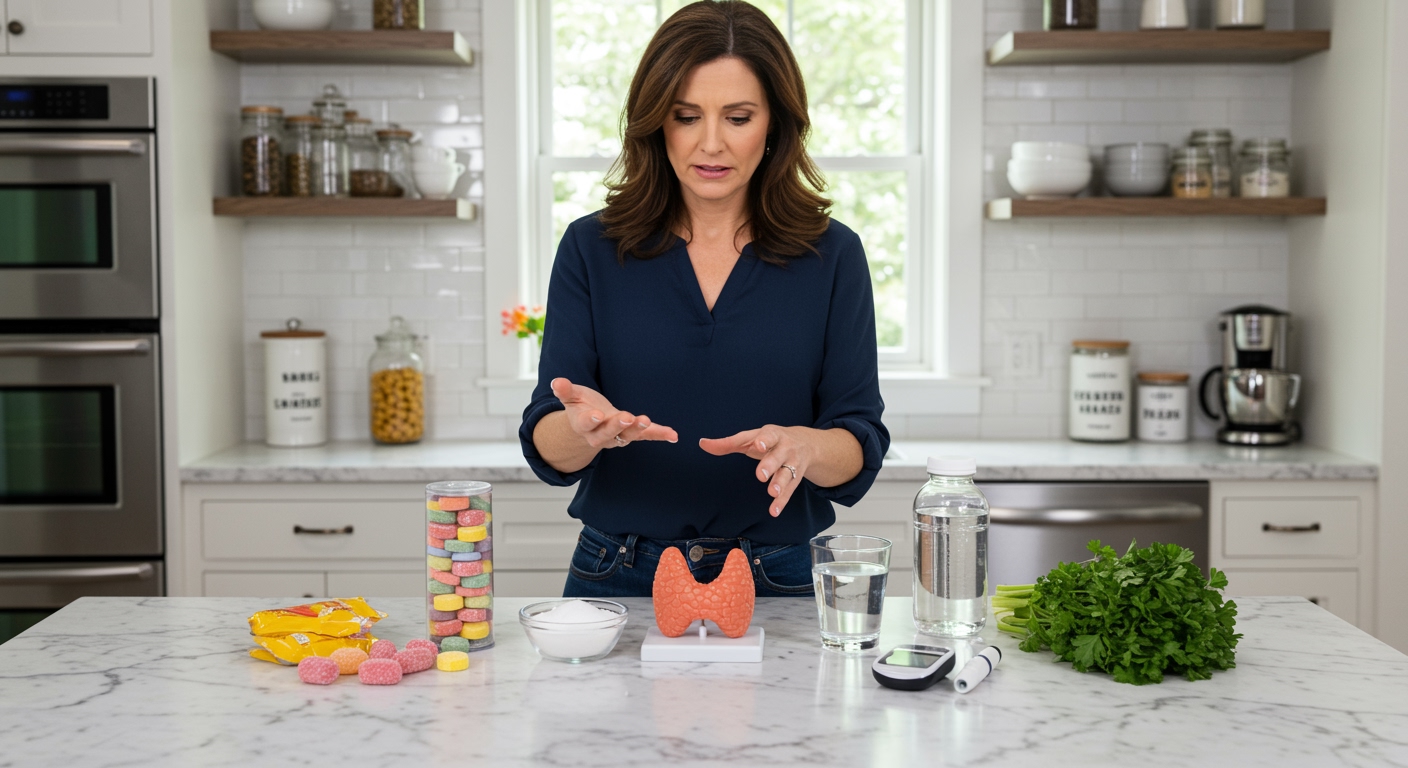✪ Key Takeaway: Jams are not always bad for hypothyroidism when chosen wisely, consumed in moderation, and paired with protein or healthy fats.
Introduction
You probably heard that people with hypothyroidism should avoid all sweet foods including jams.
This blanket advice creates unnecessary fear and confusion around something as simple as fruit spread on your morning toast.
Hi, I’m Abdur, your nutrition coach, and today I’m going to explain the real relationship between jams and hypothyroidism so you can make informed choices without unnecessary restrictions.
What Makes Jam Different From Fresh Fruit?
Jam is essentially concentrated fruit cooked down with sugar to create a thick, sweet spread.
The cooking process breaks down the fiber structure that normally slows sugar absorption in whole fruits.
This means your body absorbs the sugar from jam much faster than it would from eating the same fruit fresh.
Most commercial jams contain added sugar beyond what naturally occurs in the fruit itself.
A typical tablespoon of jam contains about 10 to 14 grams of sugar, which equals roughly 2.5 to 3.5 teaspoons of pure sugar.
The water content gets reduced during cooking, concentrating both the natural fruit sugars and any added sweeteners.
This concentration process removes most of the vitamins that would normally be present in fresh fruit, especially heat-sensitive ones like vitamin C.
✪ Fact: One cup of fresh strawberries contains about 7 grams of sugar, but one cup of strawberry jam contains over 150 grams of sugar.
How Does Sugar Affect Your Thyroid Function?
Sugar itself does not directly damage your thyroid gland or stop it from producing hormones.
However, high sugar intake creates a cascade of metabolic problems that indirectly worsen hypothyroidism symptoms.
When you eat sugar-rich foods like jam without protein or fat, your blood glucose spikes rapidly.
This spike triggers your pancreas to release insulin, which helps move glucose from your bloodstream into your cells for energy.
Repeated blood sugar spikes lead to insulin resistance, where your cells become less responsive to insulin signals.
Research shows that insulin resistance reduces the conversion of inactive thyroid hormone T4 into active T3, which your body actually uses.
This means even if your thyroid produces enough T4, your body cannot convert it properly when insulin resistance develops.
✪ Note: Insulin resistance also increases inflammation throughout your body, which further disrupts thyroid hormone production and function.
Does Jam Consumption Worsen Hypothyroidism Symptoms?
Eating jam occasionally in small amounts will not suddenly worsen your hypothyroidism.
The problem comes from regular consumption of high-sugar foods that create chronic metabolic stress.
People with hypothyroidism already have a slower metabolism, which means they burn fewer calories at rest.
Adding frequent high-sugar foods like jam makes it easier to gain weight, which is already a common struggle with this condition.
Excess body fat, especially around your midsection, produces inflammatory compounds called cytokines that interfere with thyroid hormone signaling.
Sugar also feeds harmful gut bacteria, creating an imbalance called dysbiosis that affects your immune system.
Since most hypothyroidism cases stem from autoimmune thyroid disease called Hashimoto’s, maintaining gut health becomes especially important.
✪ Pro Tip: If you experience increased fatigue, brain fog, or weight gain after eating jam regularly, consider reducing your intake for two weeks to see if symptoms improve.
Which Types Of Jam Are Better Choices?
Not all jams affect your body the same way, and some options are significantly better than others.
Look for jams labeled as fruit-only or those sweetened with minimal added sugar.
These products rely more on the natural sweetness of concentrated fruit rather than heaps of refined sugar.
Check the ingredient list and choose jams where fruit appears first and sugar appears last or not at all.
Some brands use alternative sweeteners like stevia or monk fruit, which do not spike blood sugar the way regular sugar does.
Jams made from berries like strawberries, blueberries, or raspberries contain more antioxidants and less sugar per serving than tropical fruit jams.
You can also make homemade jam using fresh or frozen fruit with chia seeds as a natural thickener, eliminating added sugar entirely.
✪ Pro Tip: Store-bought jams labeled as preserves or fruit spreads often contain slightly more fruit pieces and fiber than smooth jams, making them a better choice.
How Can You Enjoy Jam Without Harming Your Thyroid?
The key to eating jam with hypothyroidism lies in portion control and smart food pairing.
Never eat jam alone or on an empty stomach, as this causes the fastest blood sugar spike.
Always pair your jam with protein like Greek yogurt, cottage cheese, or nut butter to slow sugar absorption.
Adding healthy fats like almond butter or walnuts further reduces the glycemic impact of the sugar in jam.
Limit your serving to one tablespoon or less, which provides sweetness without overwhelming your system with sugar.
Choose whole grain bread or oats as your base instead of white bread, as the fiber helps moderate blood sugar response.
Consider having jam as part of your breakfast rather than as a snack, since morning meals typically include more protein and fat naturally.
✪ Fact: Eating protein before carbohydrates can reduce post-meal blood sugar spikes by up to 30 percent according to diabetes research.
The Bottom Line
Jams are not inherently bad for hypothyroidism when you choose quality options, control portions, and pair them with protein or healthy fats.
Health is not about perfection but about making informed choices that fit your life without unnecessary fear, and understanding how different foods affect your body empowers you to enjoy life while managing your condition effectively.
I would love to hear your experience with jams and hypothyroidism in the comments below, so please share your thoughts, questions, or any tips that have worked for you.
References
At NutritionCrown, we use quality and credible sources to ensure our content is accurate and trustworthy. Below are the sources referenced in writing this article:





